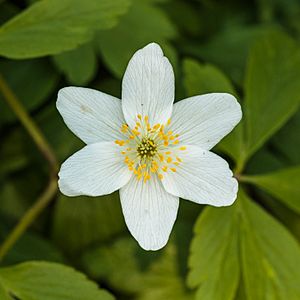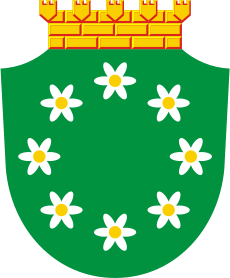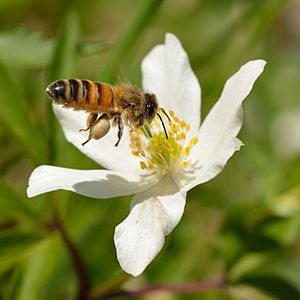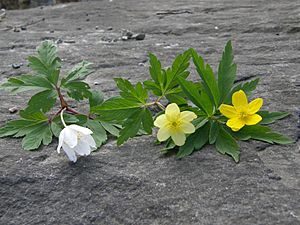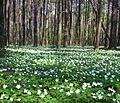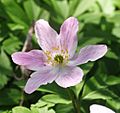Anemonoides nemorosa facts for kids
Quick facts for kids Anemonoides nemorosa |
|
|---|---|
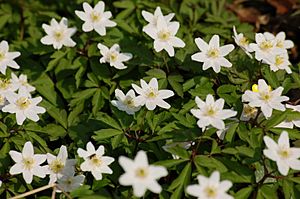 |
|
| Scientific classification | |
| Genus: |
Anemonoides
|
| Species: |
nemorosa
|
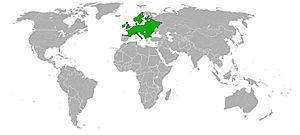 |
|
| Synonyms | |
|
|
The wood anemone, also known as Anemonoides nemorosa, is a beautiful early-spring flower. It belongs to the buttercup family and grows naturally in Europe. People sometimes call it the windflower or thimbleweed. Another funny name is smell fox, because its leaves have a slightly musky scent. This plant is a perennial herb that grows about 5 to 15 centimeters (2 to 6 inches) tall. This means it comes back year after year.
Contents
What Does the Wood Anemone Look Like?
The wood anemone is a small plant, usually less than 30 centimeters (12 inches) tall. It grows from special underground stems called rhizomes. These rhizomes help the plant spread. The leaves grow from these underground stems. They are often divided into three parts, like a clover leaf. By the middle of summer, these leaves die back, and the plant rests underground.
The flowers start to bloom in spring, usually from March to May in places like the British Isles. Each plant has one flower on a short stem. Below the flower, there are three leaf-like parts called bracts. The flowers are about 2 centimeters (1 inch) wide. They usually have six or seven petal-like parts called tepals. Sometimes they can have up to ten. In the wild, the flowers are usually white. But they can also be pink, light purple, or blue. Often, the back of the tepals has a darker color.
How to Tell it Apart from Similar Plants
There are a few plants that look a bit like the wood anemone.
- The yellow wood anemone (Anemonoides ranunculoides) is a bit smaller. It has yellow flowers and usually doesn't have leaves at its base.
- Wood sorrel also grows in shady places. You can easily tell it apart because its leaves look like clover. Its flowers are smaller, with five white petals and five sepals.
Where Do Wood Anemones Grow?
The wood anemone is native to Europe and parts of western Asia, including the Caucasus Mountains in Turkey. It has also been brought to other places, like New Zealand. In North America, you can find it growing wild in places like Newfoundland, Quebec, and Massachusetts.
You'll often find wood anemones in shady forests and woodlands. In the British Isles, this plant is very common. However, it spreads very slowly, sometimes only about two meters (six feet) in a hundred years! Because it spreads so slowly, finding wood anemones in a woodland often means it's a very old, ancient forest.
How Do Wood Anemones Help Nature?
The flowers of the wood anemone are important for pollination. Insects, especially hoverflies, visit the flowers and help them make seeds. After the flowers are pollinated, they produce small seeds called achenes.
Growing Wood Anemones in Gardens
Many different types of wood anemones have been chosen by gardeners. These special types are called cultivars. In the UK, there are over 70 different cultivars sold in nurseries. Some popular ones include:
- Alba Plena: This one has double white flowers, meaning it has many layers of petals.
- Allenii: This type has large, lavender-blue flowers, often with seven petals. It's named after a nurseryman named James Allen.
- Bowles' Purple: This cultivar has pretty purple flowers. It's named after a plantsman and garden writer, E.A. Bowles.
- Bracteata Pleniflora: This one has double white flowers with green stripes. It also has a frilly ring of bracts below the flower.
- Robinsoniana: This type has pale lavender-blue flowers. It's named after William Robinson, another famous garden writer.
- Royal Blue: As the name suggests, this one has deep blue flowers with purple backs.
- Vestal: This cultivar has white flowers with a special "anemone-centered" look.
- Virescens: This is an interesting one where the flowers have changed into small, cone-shaped groups of leaves.
Some of these cultivars, like 'Allenii', 'Robinsoniana', 'Vestal', and 'Virescens', have won the Royal Horticultural Society's Award of Garden Merit. This award means they are excellent plants for gardens.
There's also a special hybrid plant called Anemonoides × lipsiensis. It's a mix between the wood anemone and the yellow wood anemone. This hybrid has pale yellow flowers. The type called 'Pallida' is very well-known and has also won the Award of Garden Merit.
Gallery
Images for kids


